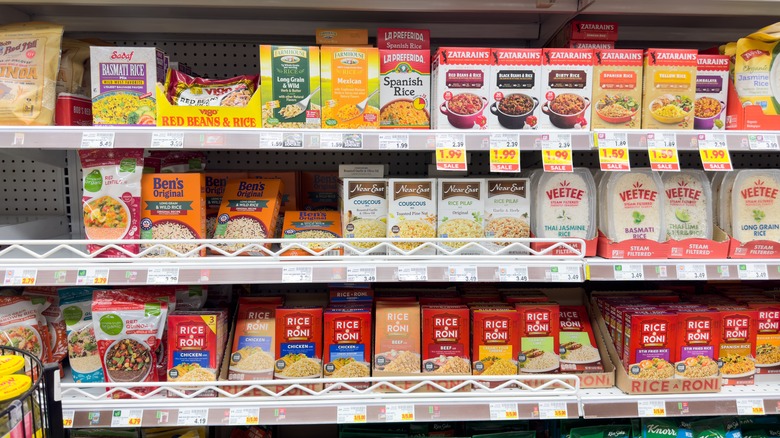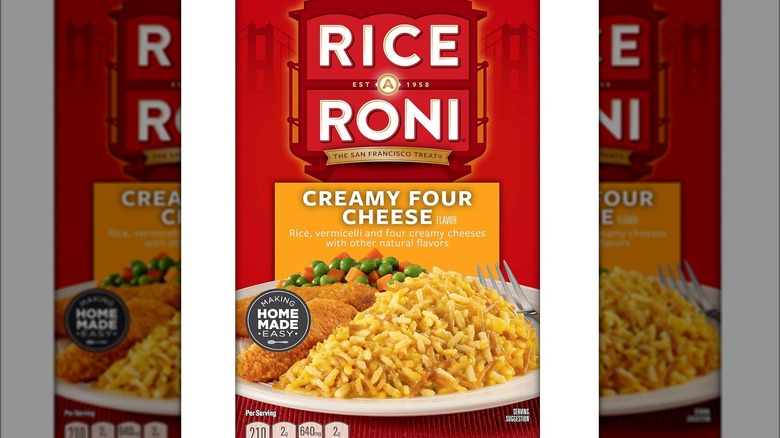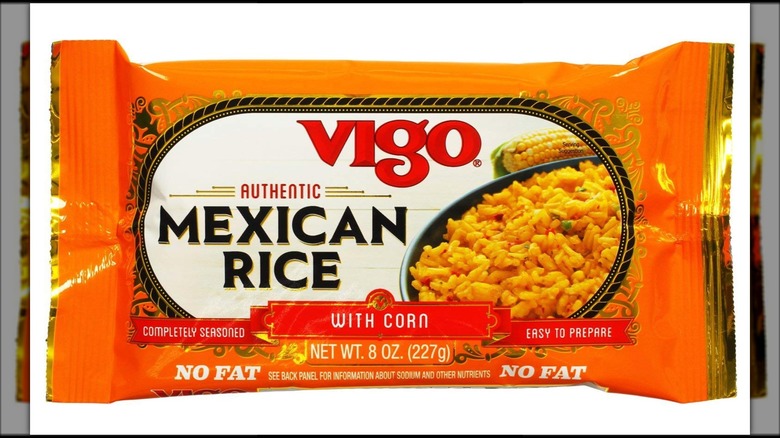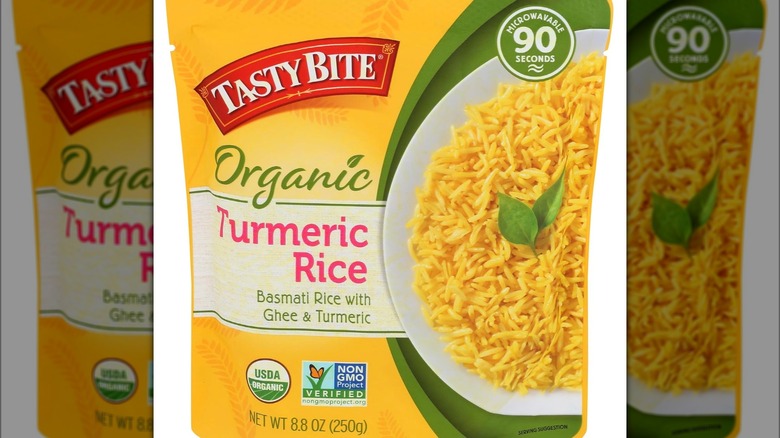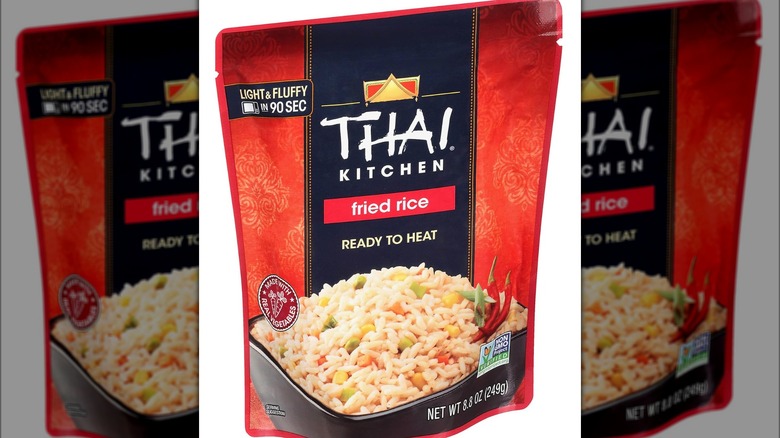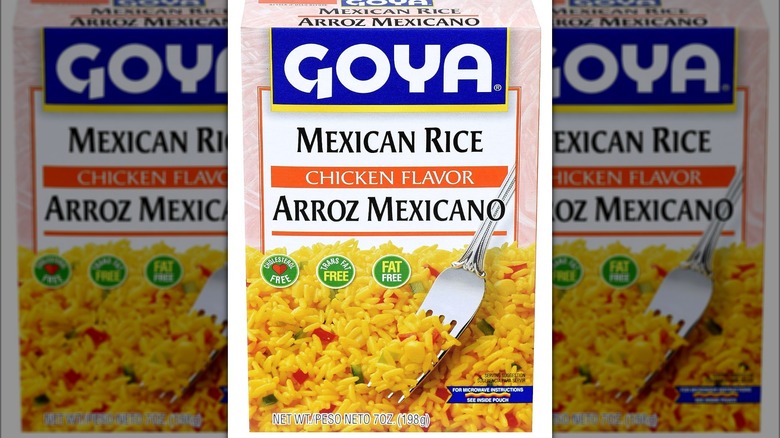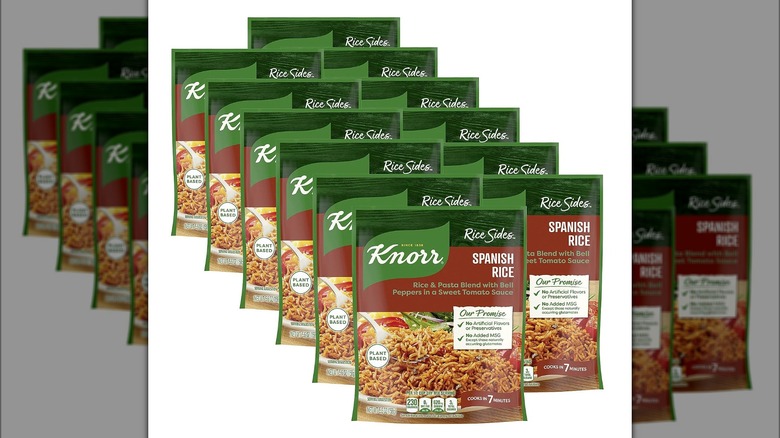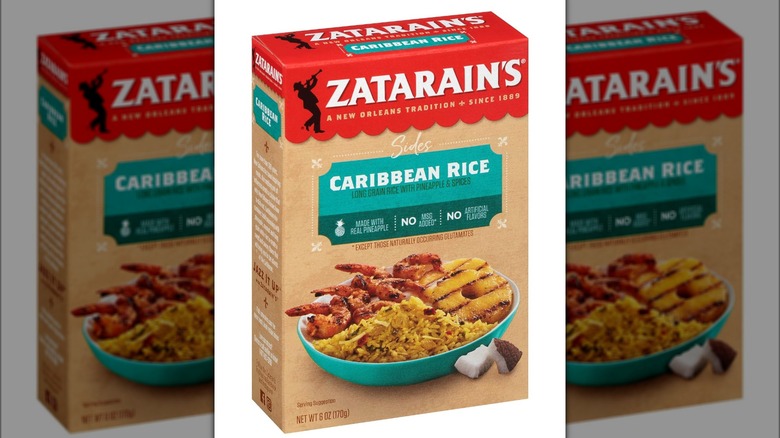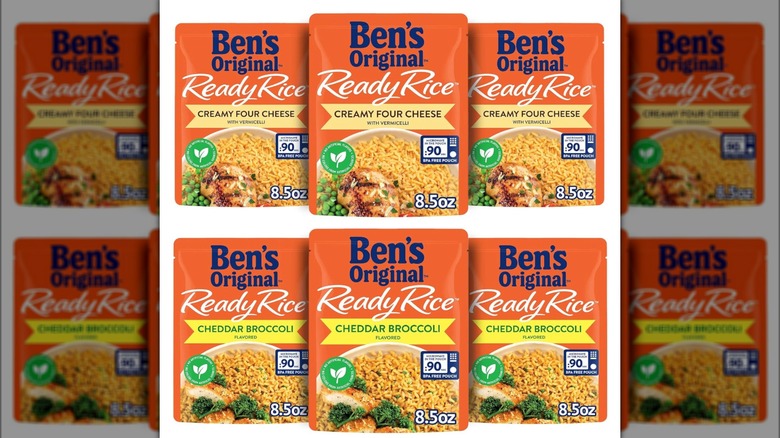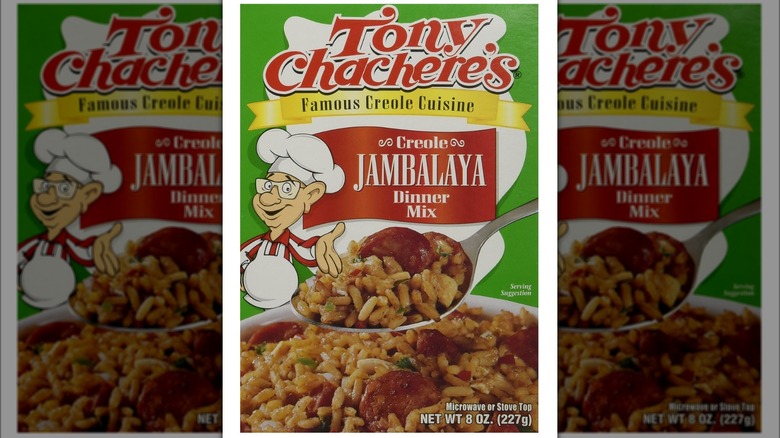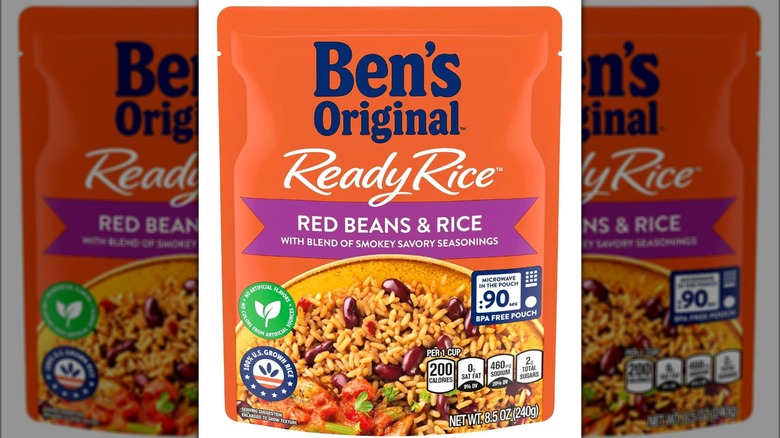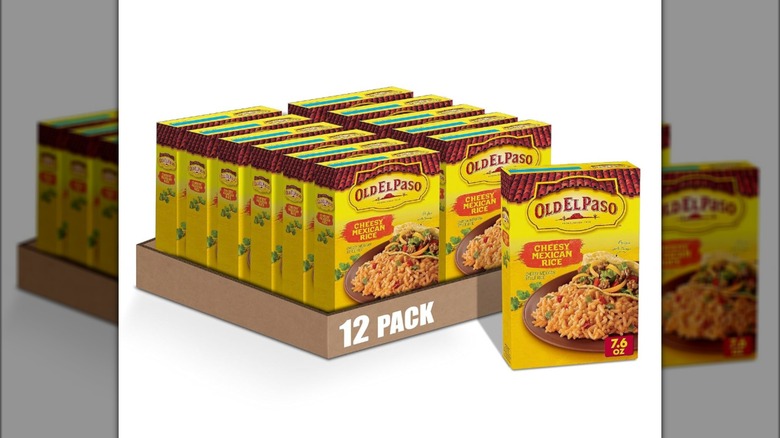11 Of The Unhealthiest Store-Bought Packaged Rice Dishes
We may receive a commission on purchases made from links.
There's one thing that jambalaya, onigiri, risotto, biryani, and nasi goreng have in common. You guessed it: Rice. Rice is so widely cultivated that it's played a formative role in the cuisine of just about every culture around the globe. Humankind has been eating rice for thousands of years. Half of the planet's caloric intake consists of about 50% rice. It's not an exaggeration to say that we owe much of our existence as a species to the nutritious prevalence of this starchy, hearty grain.
Over the years, store-bought packaged rice options have flooded the market, as demand grows for easier ways to prepare fast meals. These rice packets often come par-cooked and pre-seasoned, which saves a lot of time and effort. They're often on the table and ready to eat in a matter of minutes, and while these quick rice dishes can be extremely helpful, the truth is that their convenience often comes with a price. Many of these rice packets contain shockingly high levels of sodium, preservatives, and artificial ingredients that may be detrimental to your health.
Of course, to incorporate rice into your diet in a healthier way, it's much better to get a rice cooker and make it fresh yourself. That said, the cheap price tag of pre-seasoned rice packets gives them an alluring appeal that's hard to resist. Read on to check out some options that are probably best avoided.
1. Rice a Roni Creamy Four Cheese
Ah, Rice a Roni. Even though the company markets this as "The San Francisco treat," this boxed rice clearly has appeal well beyond The Golden City. Rice a Roni products often contain some vermicelli noodles, which gives it a somewhat spongy texture that lands somewhere between rice and pasta. Various flavors of Rice a Roni can be found in grocery stores across the country, including Herb and Butter, Chicken, and Creamy Four Cheese.
Rice a Roni's Creamy Four Cheese may sound tempting. After all, most of us tend to enjoy some creamy and cheesy goodness from time to time. But the truth is that this is definitely one of the more unhealthy rice options we've encountered. Because the recipe calls for a couple tablespoons of butter, the saturated fat content of this stuff is pretty high, with a single serving clocking in at nearly 20% of the daily recommendation. In other words, if you ate more than a cup, it would be quite possible to hit nearly half of the saturated fat that you should eat in a whole day. That's pretty outrageous for just some rice. At this point, why not just go all out and make some macaroni and cheese instead? If you're going to indulge, you might as well go big, right?
2. Vigo Mexican Rice
Vigo sells a wide variety of processed foods like bread crumbs, olive oil, and canned goods. The company has become well-known for its rice products that come in various flavors like coconut ginger, creamy avocado, and cilantro lime. Another popular flavor is Vigo's Mexican rice, which comes pre-seasoned with spices and corn.
The issue here isn't with the taste of the rice itself, which is flavorful. Rather, it's with the food colorings in the ingredients. This rice contains Red No. 3, which is a synthetic dye that's made from petroleum. For decades, the FDA has had evidence that Red. No. 3 causes cancer, which led to its ban for use in cosmetics. And yet, despite the pleas of scientists, the FDA still allows Red No. 3 to be used in countless processed foods made by some of the nation's most powerful and lucrative food companies. It's truly bizarre that food companies continue to use these dyes, knowing the potential risks, just to alter the appearance of their products. Why not just use safe, natural alternatives like turmeric or beet juice to give food products an appetizing tint? Public health experts recommend that consumers check ingredients and avoid foods that contain numbered dyes, including Red No. 3.
3. TastyBite Turmeric Rice
On the plus side, TastyBite Turmeric Rice only has a few ingredients (most of which are organic), including basmati rice, ghee, sunflower oil, salt, and turmeric. It is also very quick to make, even by packaged rice standards — only 90 seconds in the microwave, or about four minutes on the stove. The drawback comes from its sodium content, which contains over 500 milligrams per pouch.
Health-wise, you'd be much better off just making a fresh pot of rice from scratch and seasoning it yourself. That way, you can control the amount of salt and butter in the rice. While this rice isn't as unhealthy as some other options on our list here, the fact remains that it still contains an undesirable amount of sodium. Consuming too much sodium can lead to a lot of different health issues, like heart disease, high blood pressure, and stroke. The FDA recommends that people don't consume more than 2,300 milligrams of sodium a day, but the reality is that most Americans consume way more than that: 3,400 milligrams daily. It's also worthwhile to consider the fact that these rice dishes are usually just sides for a larger entree — and there's a good chance the entree itself contains a good amount of sodium. The bottom line is that homemade turmeric rice isn't necessarily difficult or time-consuming to make, so you might as well do your blood pressure a favor.
4. Thai Kitchen Fried Rice
Thai Kitchen makes products that include coconut milk, sauces and pastes, rice, noodles, and curry. The company's fried rice packet contains several ingredients, including parboiled rice, carrots, green onions, sweet corn, soy sauce powder, and ginger. Once again, the issue here isn't with taste — for rice that requires very little preparation, this stuff is decent. It all comes down to the sodium: a full pouch of this equates to about 1,250 milligrams, which seems quite high even by microwavable rice standards.
To put this into context, ust eating this pouch of rice alone would contain over half the amount of sodium the FDA recommends for an entire day. That doesn't even take into account anything else that's been eaten for breakfast, lunch, or dinner. Because fried rice is so easy to make, it's hard to justify buying this, especially when it's so high in sodium. For a fresher option, try making your own fried rice instead. You don't need a lot of ingredients to make the best fried rice you will ever try. One of the most important things is to just make sure that you have some leftover rice available in the fridge.
5. Goya Mexican Rice
Goya is a popular brand that can be found in many grocery stores across the country. The company is well-known for its beans, rice, and seasoning blends. Goya sells a variety of bagged rice including jasmine rice and brown rice, along with boxed rice like yellow rice and Mexican rice.
Goya's Mexican rice is easy to prepare and fairly tasty. Our main concern here is with the ingredients. Aside from containing artificial food dye to give the rice a yellow color, it also contains monosodium glutamate — also known as MSG. Despite MSG being used extensively across the food industry, its use remains controversial. Although the health effects of MSG are still being researched, some studies have shown that low doses of MSG can occasionally have a detrimental impact on the health of animals and humans. Some of these effects include liver damage and inflammation. That said, MSG tends to be used in small amounts, and studies show that it doesn't typically cause serious, lasting harm. At the same time, it's pretty easy to find rice that doesn't contain MSG, so why not just avoid it if you can?
6. Knorr Spanish Rice
Knorr is another prepared food company that's known for products such as gravy mixes, sauces, pasta, and rice. A big part of Knorr's appeal when it comes to rice is how low-priced it often is. Knorr's rice comes in a few different flavors, including yellow rice, Spanish rice, and Mexican rice.
To Knorr's credit, the company's Spanish rice doesn't contain any artificial flavors, artificial preservatives, or MSG. That said, the ingredients do contain something called disodium guanylate, which is a flavor enhancer similar to MSG that intensifies saltiness. Disodium guanylate metabolizes into purines, which can elevate uric acid levels and increase risk of gout or kidney stones. Disodium guanylate has been deemed safe, but thorough dosage guidelines have yet to be provided due to an absence of research on the matter. For this reason, those with a history of sensitivity to MSG may want to avoid this product. Aside from the addition of disodium guanylate, the sodium level of this rice packet is also nearly 30% of the daily recommended intake.
7. Zatarain's Caribbean Rice
Zatarain's makes products like smoked sausage, seasoning blends, and jambalaya rice. The company's Caribbean rice is a tempting buy that contains a variety of ingredients including parboiled rice, onion, coconut, pineapple, bell pepper, and garlic. The addition of pineapple provides a little touch of fruity sweetness that helps balance out its savory flavor. Once again, as is the case with a lot of prepared foods and flavored instant rice, this product is extremely high in sodium.
How high in sodium are we talking? About 1,430 milligrams, which is on the higher end of the spectrum compared to some other brands on this list. While it's true that a higher level of sodium should be expected with pre-flavored instant rice, it's still a good idea to be realistic about how eating these products on a regular basis can impact your overall health. Is the convenience really worth the tradeoff? Is saving a little time really worth the possibility of higher blood pressure that can trigger other health complications? Don't get us wrong — we definitely indulge from time to time. It's really just a matter of moderation. Regularly exposing your digestive tract and cardiovascular system to massive amounts of sodium isn't a good idea, so it's fair to say that avoiding products like this is probably best for your health.
8. Ben's Creamy Four Cheese Rice
Ben's Original produces several types of rice, many of which can be warmed up in a microwave or boiled in a bag on the stove. One of the company's popular offerings is its Creamy Four Cheese rice, which is made with rice and vermicelli pasta. The good news is that unlike some of the other options on this list, this product uses turmeric for coloring instead of synthetic food dyes. The bad news is that it's still super high in sodium, with each eight and a half ounce packet clocking in at about 36% of the sodium recommended for an entire day.
This rice is also high in carbohydrates, with one packet accounting for nearly 25% of the daily amount. Carbohydrates are sugar molecules that break down into glucose, which our bodies require for energy. Healthwise, it's often recommended that we consume whole grains like brown rice, wheat bread, and oatmeal rather than refined grains like white rice. The main difference between white rice and brown rice is that brown rice still contains bran and germ. Bran and germ are removed from white rice during processing, which makes it less nutritious. This is always something to consider when buying rice at the store, since many brands of rice, including this particular product, contain refined grains that are best consumed in moderation.
9. Tony Chacherie's Jambalaya Rice
Tony Chacherie's sells assorted types of seasonings, marinades, salad dressing, rice and more. The company's rice boxes come in a variety of styles and flavors, including gumbo, yellow rice, Spanish rice, and jambalaya rice. Tony Chacherie's jambalaya rice is made with minced onion, salt, dehydrated bell peppers, garlic powder, spices, and other ingredients. The rice is intended to be paired with meat that's not included. A mere quarter-cup of this rice is nearly 600 milligrams of sodium, or 24% of the recommended daily intake. If someone ate beyond this meager portion of rice and half of a cup, it would double to about half the day's sodium.
The real trouble here is that jambalaya is usually prepared with sausage. Sausage is extremely processed and typically quite salty — just two ounces of sausage can contain more than 400 milligrams of sodium. Because jambalaya contains so much sausage and is such an inherently salty dish already, it's fair to say that preparing it with store-bought rice like this will make it even saltier and more unhealthy. There's a very good chance that it would be healthier to try out a jambalaya recipe with fresh rice and season it yourself — and it would taste much better, too.
10. Ben's Red Beans and Rice
Rice and beans go hand-in-hand, so this pick from Ben's may seem appealing. Ben's Red Beans and Rice contains par-boiled rice and red beans, which simplifies the cooking process because customers don't have to cook a separate pot of beans. This product features a smoky flavor that gives the rice some extra complexity. Tasty as it is, the sodium content here strikes again, with one pouch delivering a whopping 33% of the recommended daily intake.
We can't deny the convenience of this product — it really doesn't get much easier than microwaving a packet for a minute or two. At the same time, using a rice cooker to make fresh rice and warming up some canned beans on the stove is also incredibly easy and far fresher-tasting. Rather than constantly succumbing to the temptations of microwavable meals, we'd recommend making rice and beans from scratch instead. Making your rice and beans may take a little more time, but your health is worth the wait.
11. Old El Paso Cheesy Mexican Rice
Old El Paso is like a one-stop shop for just about everything taco-related. The company is well-known for its tortillas, hard shell tacos, and enchilada sauce. Old El Paso also sells an assortment of other products, including taco seasoning, shredded cheese, canned beans, and boxed rice.
Old El Paso's Cheesy Mexican Rice provides an easy way to make a side that pairs well with stuffed peppers and burrito bowls. The ingredients contain dried cheeses that give the rice a creamy and cheesy texture. The spices and dried chili powder also give the rice a punch of flavor. We dig the flavor of the rice — the potential issue here isn't with the taste of the rice itself, but with the sodium level and the inclusion of calcium phosphate.
Calcium phosphate is an anti-caking agent that's used in a lot of processed foods. Supplementing diets with too much calcium may trigger a range of health issues such as gastrointestinal symptoms, kidney stones, diarrhea, and headaches. For a fresher and more delicious spin on this dish, try making a fresh pot of rice with some homemade cheese sauce instead.
